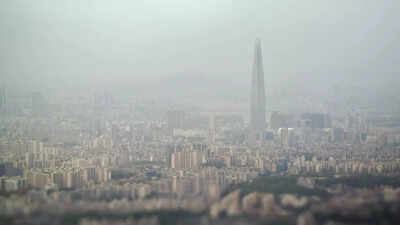
In a startling development, all forty cities ranked among the world’s most polluted on October 30, 2025, were from India, highlighting the country’s escalating air quality crisis. According to AQI data recorded at 8:30 AM, pollution levels in many northern towns crossed into the “severe” and “hazardous” range. Surprisingly, Delhi, long associated with India’s smog problem, slipped to 13th place, overtaken by smaller cities such as Sri Ganganagar, Siwani, and Abohar. This alarming shift indicates that air pollution is no longer limited to major urban centres but has spread across the northern plains. With rising particulate matter and persistent s
List of 10 most polluted cities in the world
Source: AQI
10 Polluted cities in the world
Sri Ganganagar, Rajasthan (AQI 830)Sri Ganganagar recorded an extreme AQI of 830, making it the most polluted city globally. Surrounded by agricultural regions, the city suffers from dense smoke due to stubble burning, dry dust storms, and limited wind movement, which trap pollutants near the surface and push air quality into the hazardous category.Siwani, Haryana (AQI 644)Siwani’s air quality hit an alarming AQI of 644, placing it in the severe range. The town’s pollution levels are largely driven by agricultural residue burning, vehicular emissions, and nearby industrial activities, with stagnant air during early winter preventing pollutant dispersion.Abohar, Punjab (AQI 634)Abohar in Punjab recorded an AQI of 634, reflecting the widespread environmental impact of stubble burning in the state. Agricultural smoke, dust from unpaved roads, and industrial emissions have combined to create dangerously polluted conditions, affecting visibility and respiratory health.Hisar, Haryana (AQI 477)Hisar reported an AQI of 477, putting it in the severe category. The city’s rising pollution levels stem from vehicular exhaust, construction dust, and nearby crop residue burning. Limited rainfall and calm weather during October worsened the pollution retention in the atmosphere.Churu, Rajasthan (AQI 456)Churu’s AQI of 456 shows the combined effect of desert dust, traffic emissions, and regional stubble burning. Its dry climate and sandy terrain contribute to high particulate matter concentrations, creating hazardous air conditions that affect daily life and public health.Charkhi Dadri, Haryana (AQI 448)Charkhi Dadri recorded an AQI of 448, reflecting worsening air quality in semi-urban Haryana. The city faces pollution from agricultural burning, industrial smoke, and road dust, with stagnant atmospheric conditions preventing the dispersal of fine particulate matter.Rohtak, Haryana (AQI 444)Rohtak’s AQI of 444 highlights severe pollution dominated by vehicular emissions and industrial activity. The city’s growing population, coupled with surrounding crop fires, adds to the particulate matter load, leading to poor visibility and respiratory discomfort among residents.Nangli Bahrampur, Uttar Pradesh (AQI 438)Nangli Bahrampur in Uttar Pradesh reported an AQI of 438, signalling a severe health hazard. The area’s air quality deterioration is linked to smoke from nearby agricultural fires, local industrial pollutants, and calm weather conditions that trap pollutants near ground level.Bhiwani, Haryana (AQI 437)Bhiwani recorded an AQI of 437, falling into the severe pollution zone. The city’s air is choked by a mix of vehicle emissions, dust from road construction, and cross-border smoke from crop burning. The lack of strong winds exacerbates the already poor air conditions.Sasroli, Haryana (AQI 433)Sasroli’s AQI of 433 underscores Haryana’s deepening pollution crisis. Surrounded by farmlands and industrial areas, the city experiences heavy smog formation due to a mix of stubble burning and local emissions. Reduced wind flow and cooler temperatures further trap the pollutants in the air.
Delhi’s air quality worsens despite lower global ranking
Although Delhi has dropped out of the global top 10 most polluted cities for the day, the capital’s air remains dangerously toxic. The city recorded an average Air Quality Index (AQI) of around 412, placing it firmly in the “severe” category. Thick layers of smog have blanketed the skyline, reducing visibility and posing grave health risks. Experts attribute Delhi’s current pollution levels to a combination of stubble burning in neighbouring states, vehicle emissions, industrial pollution, and construction dust.
Key causes behind India’s high pollution levels
- Seasonal and meteorological factors
In northern India, pollution spikes sharply during late October and November. Falling temperatures and weak atmospheric mixing trap pollutants close to the ground, preventing dispersion. The situation worsens as winds slow down, forming a thick smog layer that lingers for days.
- Agricultural stubble burning
One of the biggest contributors to this pollution surge is stubble burning in the agricultural states of Punjab, Haryana, and western Uttar Pradesh. Farmers burn leftover crop residue to clear fields for the next sowing season, releasing vast amounts of smoke and particulate matter into the air, which drifts into nearby regions.
- Dust, construction, and road emissions
Rapid urbanisation, construction activities, and unpaved roads generate large quantities of dust. Combined with emissions from old vehicles, particularly those running on diesel, the pollutant load increases dramatically. Many smaller cities lack adequate dust control measures, worsening the problem.
- Industrial and power plant emissions
Industrial clusters and coal-based power plants add to the emissions of sulphur dioxide (SO₂), nitrogen oxides (NOₓ), and particulate matter. Although these sources are monitored in major metros, smaller towns often operate without stringent pollution controls.Also Read | Montana Millionaire 2025 lottery: Full prize list, results date, how to take part and other details about this year’s record-breaking holiday game







